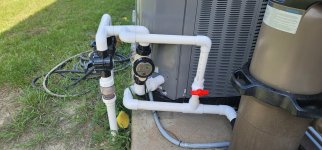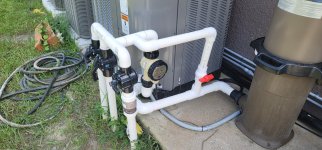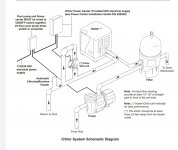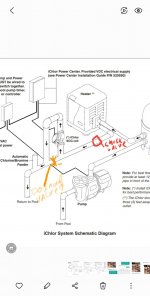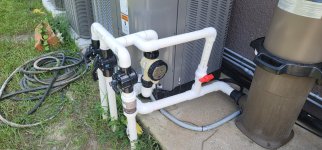This is how our PB did our plumbing, according to pentair there should be a 3' plumbing length from heater to the ichlor30, the bypass in picture was added to help pump. Would my plumbing needs to be rearrange? How should bypass be set? Any suggestions?
Does my plumbing needs rearrange
- Thread starter Kenepo17
- Start date
You are using an out of date browser. It may not display this or other websites correctly.
You should upgrade or use an alternative browser.
You should upgrade or use an alternative browser.
K,
Your pool builder is an idiot!!!
You really don't want the cell that close to the heater and I suspect there should be some straight pipe before the cell..
I'd have the pool builder come back and do it correctly.
Thanks,
Jim R.
Your pool builder is an idiot!!!
You really don't want the cell that close to the heater and I suspect there should be some straight pipe before the cell..
I'd have the pool builder come back and do it correctly.
Thanks,
Jim R.
ferretbone
In The Industry
It's a good thing that phisher price check valve has unions, because you will be pulling that thing off soon. That drain plug location for the salt cell is useless. Why is it facing up? When the pump stops running the Chlorine from the salt cell will just dump into the heater, and sit there all night every day. You will be lucky to get 6 months from that heater before its leaks enough to need a full by pass.
I will be stealing those pictures for ed, and will submit them to the iispa newsletter if you don't mind.
Call them back and point that out. That heater has no chance without a check valve.
I will be stealing those pictures for ed, and will submit them to the iispa newsletter if you don't mind.
Call them back and point that out. That heater has no chance without a check valve.
I prefer fix myself lol planning do like the pentair manual suggestsK,
Your pool builder is an idiot!!!
You really don't want the cell that close to the heater and I suspect there should be some straight pipe before the cell..
I'd have the pool builder come back and do it correctly.
Thanks,
Jim R.
Attachments
See pic like that?It's a good thing that phisher price check valve has unions, because you will be pulling that thing off soon. That drain plug location for the salt cell is useless. Why is it facing up? When the pump stops running the Chlorine from the salt cell will just dump into the heater, and sit there all night every day. You will be lucky to get 6 months from that heater before its leaks enough to need a full by pass.
I will be stealing those pictures for ed, and will submit them to the iispa newsletter if you don't mind.
Call them back and point that out. That heater has no chance without a check valve.
Attachments
- Jul 21, 2013
- 53,006
- Pool Size
- 35000
- Surface
- Plaster
- Chlorine
- Salt Water Generator
- SWG Type
- Pentair Intellichlor IC-60
Put in a heater bypass while you are fixing things…
 www.troublefreepool.com
www.troublefreepool.com
Use all diverter valves and remove the ball valves.
Heater Bypass - Further Reading
Use all diverter valves and remove the ball valves.
Thanks will doPut in a heater bypass while you are fixing things…
Heater Bypass - Further Reading
www.troublefreepool.com
Use all diverter valves and remove the ball valves.
K,
You do not need a check valve between the cell and the heater.. A check valve would be required if you were using a tab feeder.. It is not high FC that eats a heater, it is very low pH from the acid in the tablets that can eat a heater in no time at all.
When a SWCG is off, it is off, there is absolutely nothing that will flow from a SWCG back into the heater.
Thanks,
Jim R.
You do not need a check valve between the cell and the heater.. A check valve would be required if you were using a tab feeder.. It is not high FC that eats a heater, it is very low pH from the acid in the tablets that can eat a heater in no time at all.
When a SWCG is off, it is off, there is absolutely nothing that will flow from a SWCG back into the heater.
Thanks,
Jim R.
Can this valves be used?K,
You do not need a check valve between the cell and the heater.. A check valve would be required if you were using a tab feeder.. It is not high FC that eats a heater, it is very low pH from the acid in the tablets that can eat a heater in no time at all.
When a SWCG is off, it is off, there is absolutely nothing that will flow from a SWCG back into the heater.
Thanks,
Jim R.
Attachments
- Jul 21, 2013
- 53,006
- Pool Size
- 35000
- Surface
- Plaster
- Chlorine
- Salt Water Generator
- SWG Type
- Pentair Intellichlor IC-60
Can this valves be used?
No, that is a ball valve that will stick and break within a few years. Use diverter valves.
You think i can cut the white pvc of my diverter valves and slip a 2" over so i can re use them?No, that is a ball valve that will stick and break within a few years. Use diverter valves.
Attachments
I recently used a heat gun on PVC and a pliers to remove an adapter from inside another piece. It came out real clean after about 10 mins of heat and working it with the pliers. Note - time will vary depending on how high of setting on heat gun.
Do you think you need to mess with the existing diverter valves? Can you cut at that tee junction leading to horizontal pipe going to the 3 return pipes? I would try to go back into that tee fitting if you can get that small nipple out of it.
Do you think you need to mess with the existing diverter valves? Can you cut at that tee junction leading to horizontal pipe going to the 3 return pipes? I would try to go back into that tee fitting if you can get that small nipple out of it.
- Jul 21, 2013
- 53,006
- Pool Size
- 35000
- Surface
- Plaster
- Chlorine
- Salt Water Generator
- SWG Type
- Pentair Intellichlor IC-60
You think i can cut the white pvc of my diverter valves and slip a 2" over so i can re use them?
Yes, if the existing pipe is 1.5”.
Read…
PVC Repair - Further Reading
I will tryI recently used a heat gun on PVC and a pliers to remove an adapter from inside another piece. It came out real clean after about 10 mins of heat and working it with the pliers. Note - time will vary depending on how high of setting on heat gun.
Do you think you need to mess with the existing diverter valves? Can you cut at that tee junction leading to horizontal pipe going to the 3 return pipes? I would try to go back into that tee fitting if you can get that small nipple out of it.
ferretbone
In The Industry
Who is doing the warranty for this heater, Pentair, Jandy, Hayward ? They all say put a check valve between the heater and salt cell..K,
You do not need a check valve between the cell and the heater.. A check valve would be required if you were using a tab feeder.. It is not high FC that eats a heater, it is very low pH from the acid in the tablets that can eat a heater in no time at all.
When a SWCG is off, it is off, there is absolutely nothing that will flow from a SWCG back into the heater.
Thanks,
Jim R.
This is what I see in that pic, when the pump stops, yes so does the chlorine production. What about the chorine already produced? From that salt cell in that picture mounted horizontal right in front of the heater. It looks like to me when the pump stops the chlorinated water just dumps into the heater with no excape. Even salt cells chlorine is corrosive. Concentrated chlorine dumped in the heater when the pump stops, left to sit for hrs everyday? Maybe the bottom half of the heater is plastic, maybe not I dont know, but if you and I had to cover the warranty for this heater I'd like to think we could come up with a reason why we wouldn't cover it based on the plumbing like the manufacturers do.. Or we could just shove the warranty info into his face and say we said use a check valve stupid, or the heater will not be covered under warranty reguardless of what you think you know about scaling or corrosion in this heater.
"Automatic chemical dosing devices and salt chlorinators are usually more efficient in heated water, unless controlled, they can lead to excessive chlorine level which can damage your heater, and which is not covered under warranty. A check valve should be installed between the heater outlet and a chlorinator or other chemical dosing device."
-Raypack.
Check valves are only $50 bucks.
Last edited:
Please explain your theoryAutomatic chemical dosing devices and salt chlorinators are usually more efficient in heated water, unless controlled, they can lead to excessive chlorine level which can damage your heater,
Its a new pool only 30+ days, i just added salt and started chlorinator, also i run my vs pump at low speed overnight.Who is doing the warranty for this heater, Pentair, Jandy, Hayward ? They all say put a check valve between the heater and salt cell..
This is what I see in that pic, when the pump stops, yes so does the chlorine production. What about the chorine already produced? From that salt cell in that picture mounted horizontal right in front of the heater. It looks like to me when the pump stops the chlorinated water just dumps into the heater with no excape. Even salt cells chlorine is corrosive. Concentrated chlorine dumped in the heater when the pump stops, left to sit for hrs everyday? Maybe the bottom half of the heater is plastic, maybe not I dont know, but if you and I had to cover the warranty for this heater I'd like to think we could come up with a reason why we wouldn't cover it based on the plumbing like the manufacturers do.. Or we could just shove the warranty info into his face and say we said use a check valve stupid, or the heater will not be covered under warranty reguardless of what you think you know about scaling or corrosion in this heater.
"Automatic chemical dosing devices and salt chlorinators are usually more efficient in heated water, unless controlled, they can lead to excessive chlorine level which can damage your heater, and which is not covered under warranty. A check valve should be installed between the heater outlet and a chlorinator or other chemical dosing device."
-Raypack.
Check valves are only $50 bucks.
Bone,
If I were in the business of installing new pool equipment and had to worry about warranties, then I would install a check valve just to make sure there were not any warranty issues..
That said, I believe in science, and not magic, and stand by my original statement that there is absolutely nothing produced by a salt cell that can harm a heater in any way... The idea that there is "high" chlorine levels in the cell are just not true.. One of the main disadvantages of a saltwater pool is that you have to run it longer for the cell to be able to produce the amount of chlorine a pool needs each day.. This is because the cell makes very little chlorine at any one time..
To be clear.. I said you do not "need" a check valve between the cell and the heater.. But, installing one does not cause any real issues, except having to run your pump at a slightly higher RPM. I have no issue with people that want to have a check valve there.. as long as they understand it will make zero difference in whether the heater corrodes or not, unless you have a tab feeder.
Thanks,
Jim R.
If I were in the business of installing new pool equipment and had to worry about warranties, then I would install a check valve just to make sure there were not any warranty issues..
That said, I believe in science, and not magic, and stand by my original statement that there is absolutely nothing produced by a salt cell that can harm a heater in any way... The idea that there is "high" chlorine levels in the cell are just not true.. One of the main disadvantages of a saltwater pool is that you have to run it longer for the cell to be able to produce the amount of chlorine a pool needs each day.. This is because the cell makes very little chlorine at any one time..
To be clear.. I said you do not "need" a check valve between the cell and the heater.. But, installing one does not cause any real issues, except having to run your pump at a slightly higher RPM. I have no issue with people that want to have a check valve there.. as long as they understand it will make zero difference in whether the heater corrodes or not, unless you have a tab feeder.
Thanks,
Jim R.
- Jul 21, 2013
- 53,006
- Pool Size
- 35000
- Surface
- Plaster
- Chlorine
- Salt Water Generator
- SWG Type
- Pentair Intellichlor IC-60
Put in the Heater Bypass I recommend and you get a CV on the heater output as part of it.
Thread Status
Hello , This thread has been inactive for over 60 days. New postings here are unlikely to be seen or responded to by other members. For better visibility, consider Starting A New Thread.


